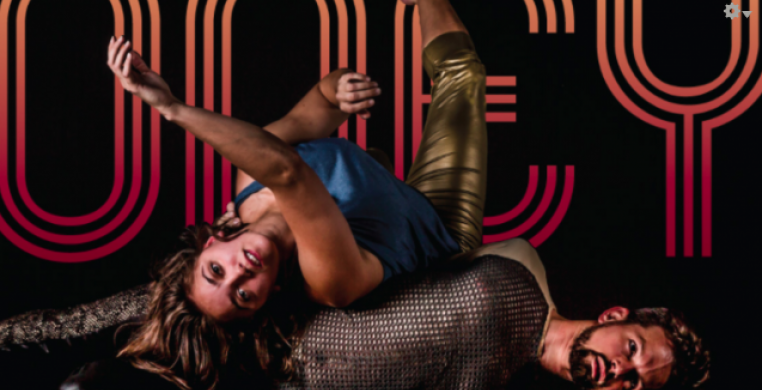Gold balloons form a cascading pile in the upstage corner of the room, not unlike the snowdrifts forming just outside Dovetail Studios Dec. 11 for the final showing of “Honey,” Joanna Rosenthal Read’s latest work. The event is a coming out of sorts –Read unveiled a new name for her company – replacing Same Planet Different World with the less committal Same Planet Performance Project – plus a whole new roster of dancers and a promising new performance space at her home studio in Albany Park. In front of the balloons is a carefully placed mess of vinyl records, some whole and some broken, and a few disco balls dangling above. The rest of the room is dressed in silver lamé, replacing conventional theater drapery and priming an intimate audience for a psychedelic adventure. “Honey” is inspired by disco, but this is no Xanadu or Saturday Night Fever. In her program notes, Read points out that the music and the movement cannot be summed up in a single dance. “Honey” plays in the subtler spaces of the era, hinting at the socio-political movements underpinning the club scene rather than speaking directly about sex, drugs and…disco.
Same Planet typically requires artists with an outstanding technical base who are willing to be weird. This can be a difficult combination to come by, but in her cast of four: Michelle Giordanelli, Kate Klingsbury, Christopher Knowlton and Michael O’Neill, Read pretty much nailed it. At the top of the piece the quartet stands in a clump facing the strong diagonal (upstage left to downstage right). Lighting designer Joshua Paul Weckesser shines a light in the same direction, casting a warm glow on the dancers’ backs, projecting their shadows onto the lamé. Giodanelli is the first to move, starting with a tiny shift in the pelvis, and a slow shampoo arm, but in reverse. Cars zooming by outside Dovetail’s converted garage doors offer a break to the silence, giving the methodical movement a sound score of sorts. Eventually the others join, with similar movements but out of sync; together they are a slow-motion club dance that gets gradually (very gradually) faster while increasing the volume and pace of their breath. Audible exhales, undulating pelvises and muppet arms overhead are obviously a climax of this piece – literally and figuratively – a contemplative, disinterested orgasm, perhaps. I thought at first the piece was too slow to develop, but it was worth the wait.
From there “Honey” breaks into more conventional dancing, with a hint at the free love and fantasy from which Read takes her inspiration. The dancers get close, uncomfortably close, breathing on each other’s necks with a glossy stare. They are disinterested in us and each other, with most of the emotion wiped off their faces. I think it’s intentional, and a welcome departure from cheesier attempts to unpack disco. It’s like we are witnessing individuals on a psychedelic trip, and knowing that they are in another time or place but only seeing the disconnect from reality. The dancing itself is crisp and exciting, although I wanted more of it.
“Honey” obeys many of the conventions one can observe in Read’s body of work. It is technically and structurally sound, and arcs in all the right places. Read’s greatest strength is her ability to mine movement from whatever topic she’s exploring and strip away most of the literal references to that thing. Thus, the idea she’s playing with is expanded and goes to new, undiscovered places. “Honey” does that too, but it also feels different from her previous works – although I can’t pin down why that is. It’s exciting to see a choreographer continue to stretch after many years of successful dancemaking. Even though her priority right now is probably Dovetail Studios, “Honey” reaffirms Read’s place as an important choreographic voice in Chicago’s dance community.

